When traveling to Florence, there’s one landmark that stands head and shoulders above the rest as an absolute must-see attraction: the Cathedral of Santa Maria del Fiore, simply known as the Florence Duomo.
While the Duomo and its famous Brunelleschi Dome may be famous worldwide, not everyone knows that the cathedral is just one piece of the spectacular Duomo Complex.
| ⌛ Planning your trip to Florence at the last minute? Here are my quick picks on what to do & where to stay! ⛪ Top Florence Duomo Tours: 1. 2-Hour Guided Tour with Cathedral, Dome + 72 Hour Complex Pass (the full package!) 2. Skip-the-Line Cathedral + Dome + 72 Hour Pass (no tour guide) 3. Cathedral Only Guided Tour (no dome climb) 🍷 Other Florence Must-Dos: 1. Tuscany Food and Wine Tour (highly-rated small group tour) 2. Art Tour of the Uffizi & Accademia (see the Uffizi & Statue of David) 3. Boboli Gardens Entrance Ticket (best views of Florence) 🏨 Best Florence Hotels: 1. Cicerone (charming central Florence guesthouse) 2. Piccolo Borgo Antico (quiet studios near Boboli Gardens) 3. Hotel Unicorno (beautifully revamped 17th century building) ✈️ Flying in? Book an airport transfer with Welcome Pickups — they’ll greet you at the airport, help with bags, & bring you into the city, all pre-booked! |
You can visit the imposing cathedral free of charge, but you’ll find many other Florence landmarks in Piazza del Duomo that you can access for a fee.
There’s a lot to see in this complex of buildings, so you’ll want to decide what you want to prioritize, partly based on how much time you have in Florence.
You can choose between several ticket types that give you access to some or all the landmarks, some for 72 hours.
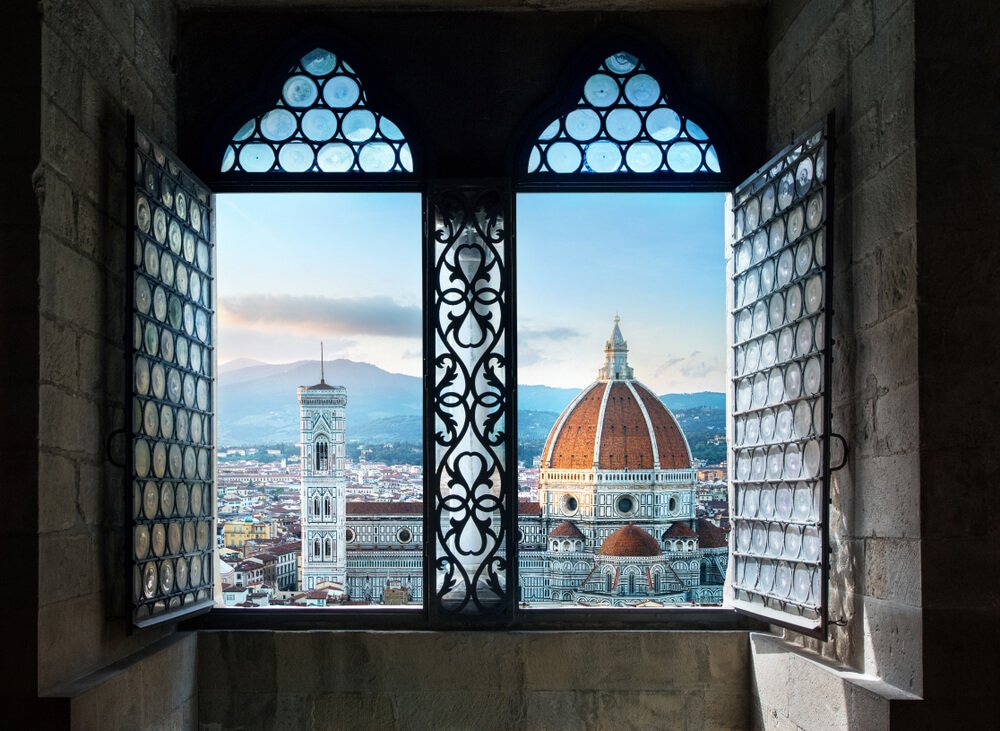
Before getting into the ticket types and other useful things to know before visiting the Duomo in Florence (and why it really ought to be on your Florence itinerary), let’s have a quick history lesson to catch you up on the fascinating history of what was once the largest cathedral in the world!
Whether you have but one day in Florence, a full week, or more: you can’t miss this!
Table of Contents
A Brief History of the Florence Duomo

First of all, let’s get terms straight: Duomo means ‘Cathedral’ in Italian, so this building is not to be confused with the Milan Duomo or any other cathedral in Italy.
Good? Now let’s get started!
The lengthy construction of the Florence Duomo started in 1296, but would not be completed until almost a century and a half later, in 1436.
Since it spanned nearly 150 years, as you can imagine, several architects needed to be involved.
The result? A unique church combining a variety of popular architectural styles that reflect the architectural zeitgeist, including Renaissance and Gothic elements.
When completed, the Duomo was the largest church in the world; it has since been upstaged by St. Peter’s Basilica in Vatican City.
The construction of the cathedral began during a flourishing period in Florence’s history, and it was constantly interrupted due to external events.
The church was initially designed by Arnolfo di Cambio, but the design changed significantly as other architects took over the project.
The Duomo’s stunning dome was designed by Filippo Brunelleschi was one of the last parts of the church to be finished, not until 1436.
The imposing dome was an engineering feat at the time, but it remains one today: it’s still the largest masonry vault in the world even now!
Although it was not yet complete, the church was dedicated to Santa Maria del Fiore in 1412, a clear tribute to the city’s symbol, the Florentine iris.
The cathedral’s façade, one of the most impressive features alongside the dome, also looked very different at the time of completion when compared to its current appearance.
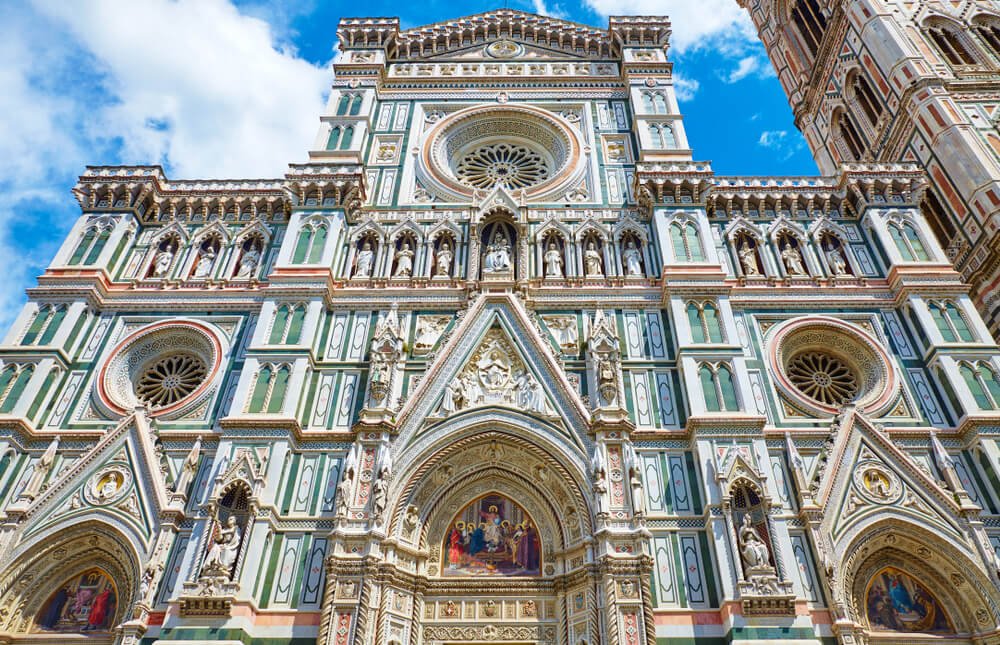
In 1587, the Grand Duke Francesco I de’ Medici decided to replace it entirely. The decorative elements of the original façade are now on display inside the Museo dell’Opera del Duomo.
However, the changes weren’t over yet, and the façade as you see it today is just a century old.
The cathedral saw significant renovation work during the 19th century, the most impressive one being the decoration of the façade with white, green, and red marble done by Emilio De Fabris between 1871 and 1884 to match Giotto’s Bell Tower.
Towards the end of the 20th century, extensive archaeological excavations uncovered the ruins of an ancient church right below the Florence Duomo.
Archaeologists soon identified the Church of Santa Reparata, the ancient city cathedral which replaced the San Lorenzo Cathedral.
The Landmarks of the Florence Duomo Complex
In addition to the Cathedral of Santa Maria del Fiore, the Duomo Complex includes the Baptistery of St. John, Giotto’s Bell Tower, the Opera del Duomo Museum, and the Church of Santa Reparata.
Depending on the ticket for the Duomo you purchase, you can visit all the landmarks or just a few highlights.
Before you make your choice, here’s a quick overview of what to expect from each landmark of the Duomo Complex.
Cathedral of Santa Maria del Fiore
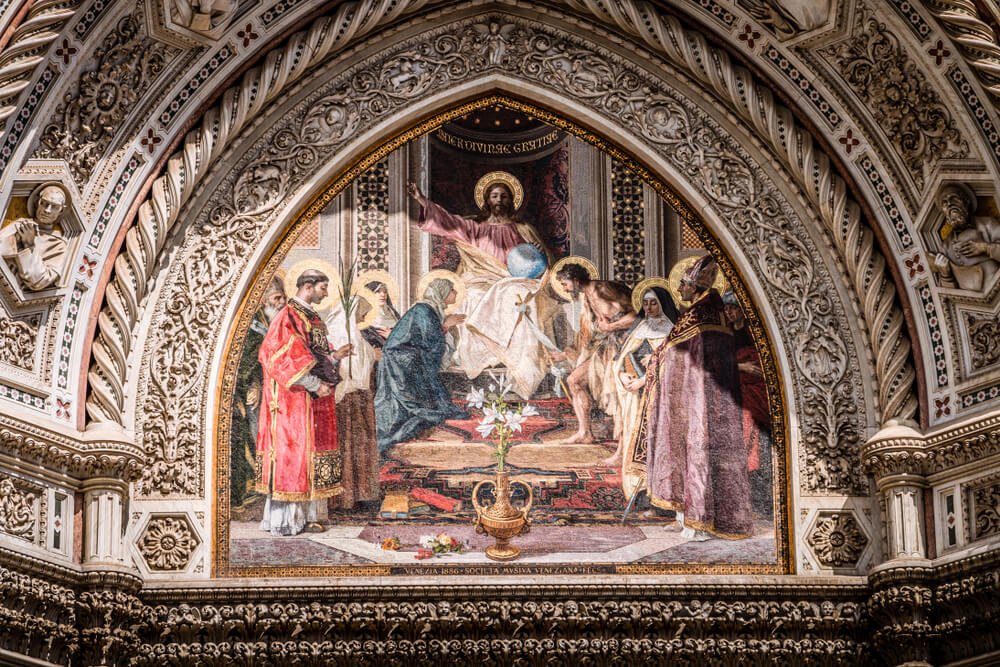
After admiring the beautiful marble façade of the cathedral with its decorative elements and colorful mosaics — including the famous one above — step inside to discover the inside.
Entry to the Duomo itself is free, and you can check out the beautiful artwork inside.
The inside has a very simple appearance compared to the ornate exterior, but you can admire an absolute treasure trove of art.
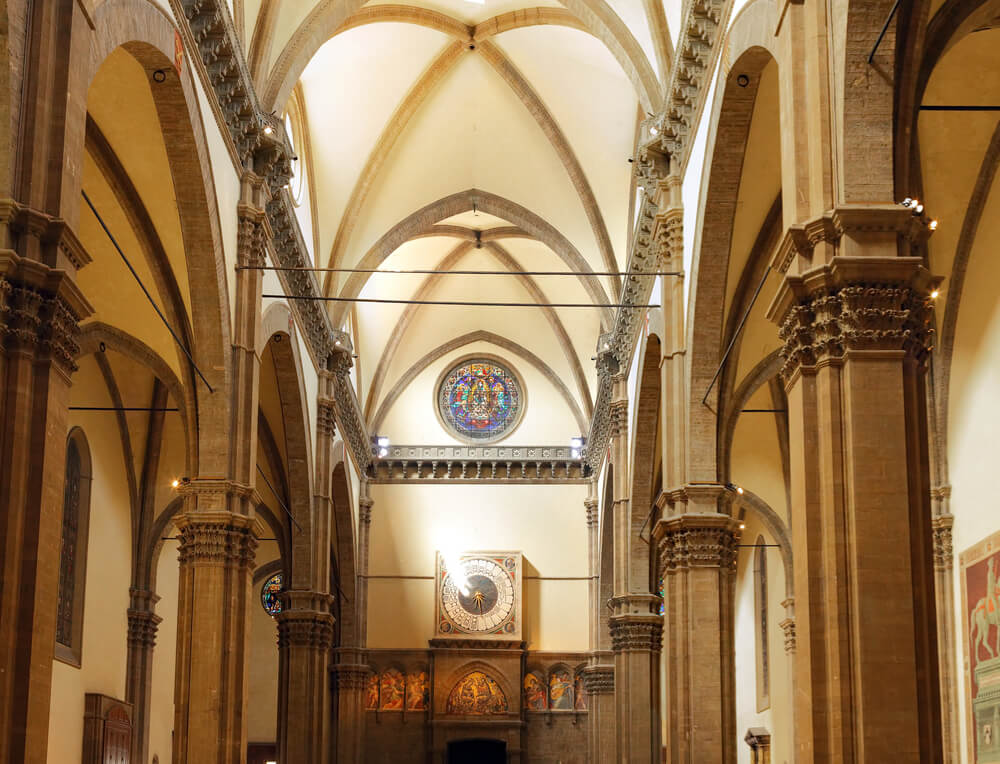
These works include Renaissance paintings and frescoes.
You can also find busts of key personalities from the city’s history like Giotto and Brunelleschi and other sculptures.
And of course, there’s the interior of the dome — but that warrants its own section, now.
Brunelleschi’s Dome

Warranting a separate section all of its own, while Brunelleschi’s Dome is part of the Florence Duomo, it requires a separate entry with a time slot reservation.
It’s worth the extra effort through to see this marvelous dome covered in a fresco by Vasari and Zuccari representing The Last Judgment.
For a closer look at the wonderful fresco on the dome’s vault, you’ll have to buy a ticket that includes the climb to the Brunelleschi Dome.
It’s worth the extra price to see the stunning close-up of the fresco that will allow you to admire the impressive details!

However, if you do so, not only will you be able to see this fresco, you’ll also be able to admire the panoramic view of Florence from above.
I mean, just look at those epic views from the top!
I’d say it’s worth all those stairs you have to climb.
Church of Santa Reparata
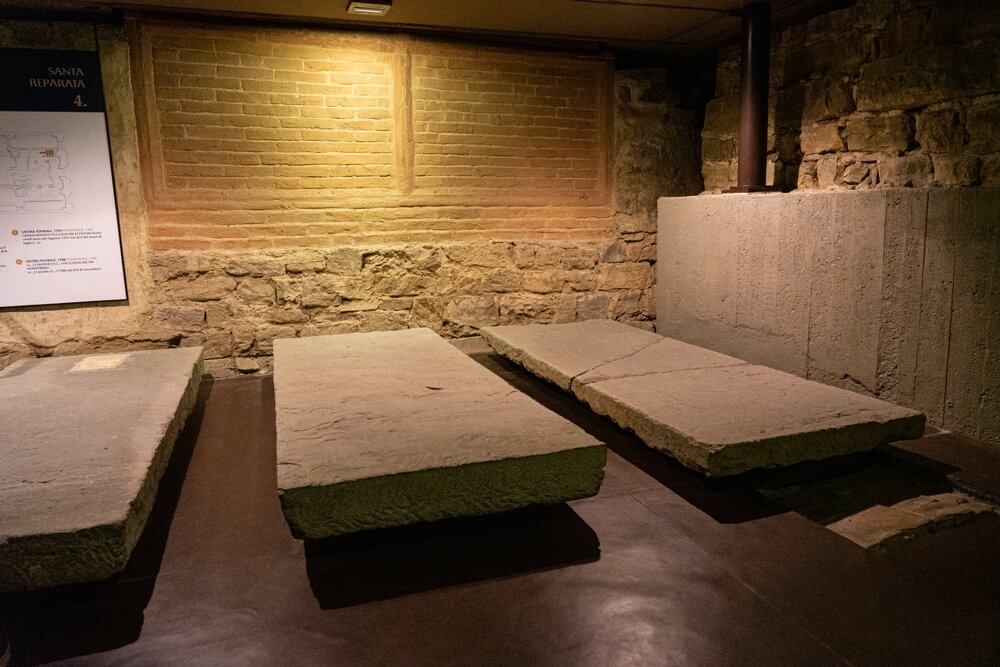
The ancient paleo-Christian church of Santa Reparata now serves as the crypt of the Florence Duomo.
The church likely dates to the early 5th century and later replaced San Lorenzo as the city cathedral.
The Church of Santa Reparata served as Florence’s main cathedral until 1379 when it was demolished to make space for the current cathedral.
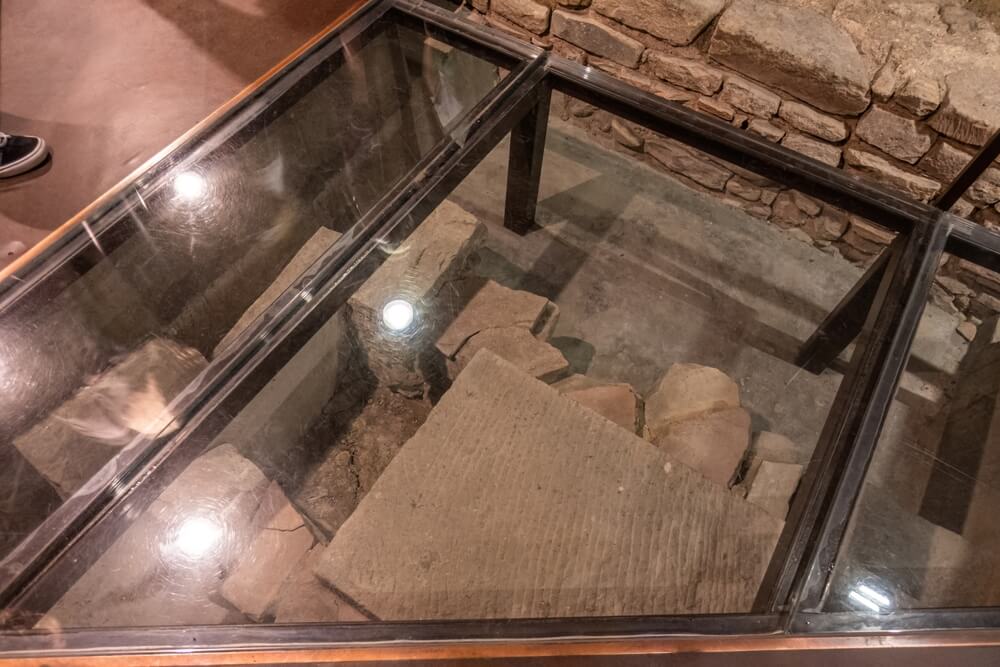
If you visit the underground, you can still see well-preserved, colorful mosaics on the floor, frescoes, and tombstones.
Glass floors show you the original stonework!
The access to the ancient church is inside the Duomo, but be warned, it’s only accessible for a fee, or as part of a pass.
Giotto’s Bell Tower
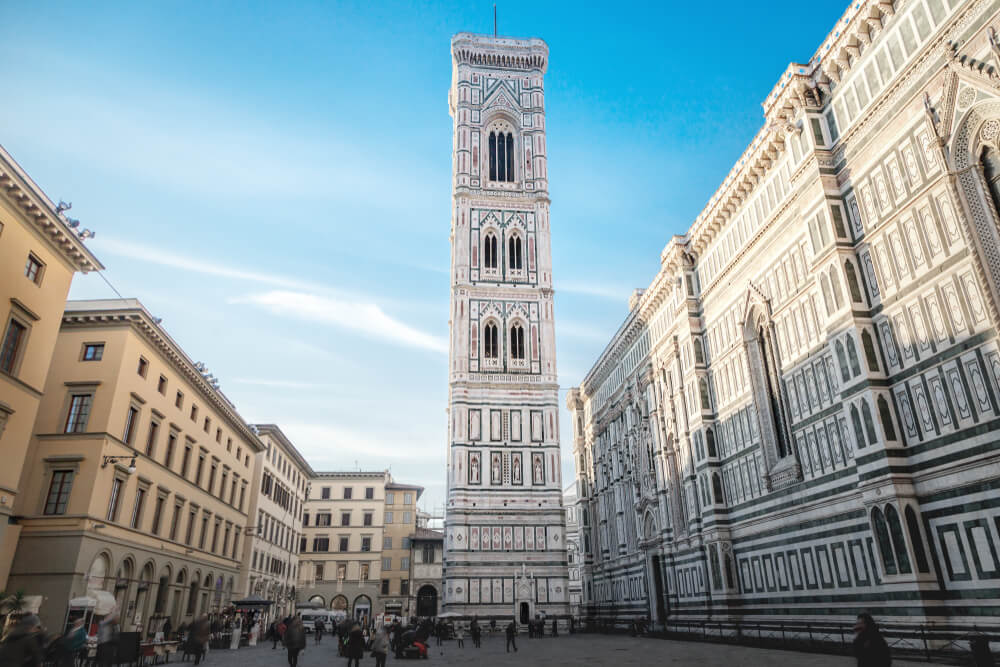
Giotto’s Bell Tower is widely considered the most beautiful bell tower in Italy, completely covered in red, green, and white marble from the various regions of Tuscany.
Giotto started working on the bell tower project in 1334 but tragically could only complete a small part before his death in 1337.
The work was continued by Andrea Pisano and Luca della Robbia over the following years and completed in 1359.
On top of the beautiful marble decoration, the tower includes many decorative elements, including bas-reliefs and statues of key personalities.
The statues you now see on the tower are copies, while the originals are kept in the Opera del Duomo Museum (also on this list!)
If you ask me, the absolute best part of the tower is the top terrace offering sweeping views of Florence.
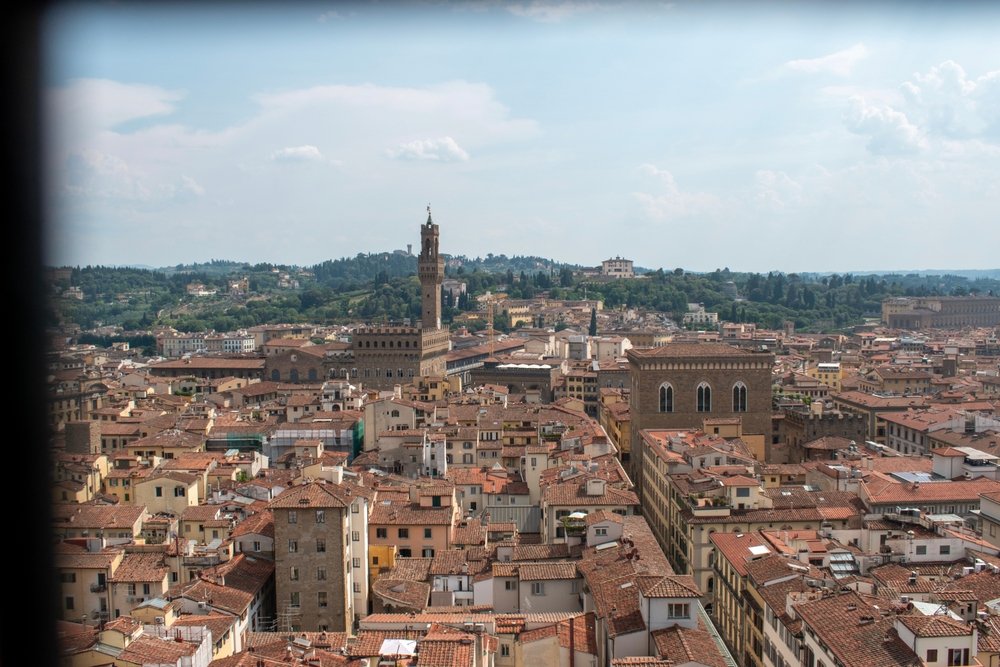
It’s a truly magnificent view!
However, climbing to the top of the tower may not be for everyone. There’s over 400 stairs leading to the top, and the narrow stairway can be challenging.
Access is not recommended for people suffering from cardiovascular conditions or claustrophobia.
Baptistery of St. John

Next to the Florence Duomo, the octagonal Baptistery of St. John is among the oldest churches in Florence.
Although the origins of the church are uncertain, several decorative elements on the outside, including part of the marble, were likely reclaimed from ancient pagan buildings.
The baptistery you can now admire is the result of a renovation of an older one, likely dating back to the 4th or possibly 5th century.

The inside of the baptistery was decorated with stunning mosaics by local artists in the 13th century.
The three main doors of the church were designed and decorated by significant artists, including Andrea Pisano and Ghiberti.
Note that many artworks that previously adorned the baptistery are now on display in the Opera del Duomo Museum.
Opera del Duomo Museum
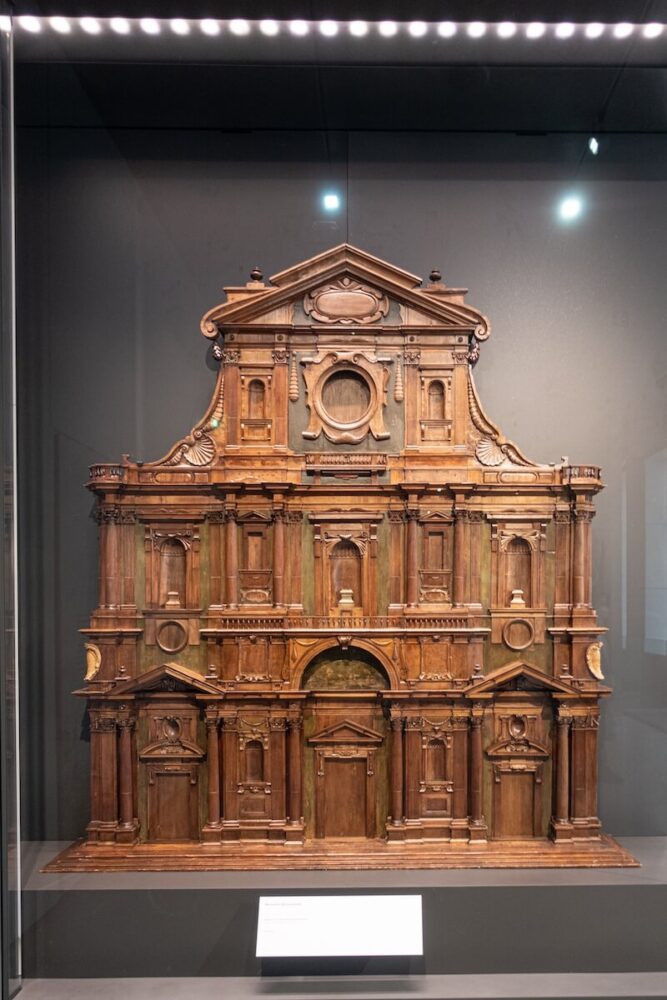
The final part of the Duomo Complex, the Opera del Duomo Museum, contains the original artworks that were inside the monuments and several decorative elements.
As we’ve mentioned throughout the piece so far, many works have been removed from their original location in the Duomo Complex and placed here.
The small but mighty museum houses works by some of the greatest Renaissance artists of this time period, including Michelangelo, Donatello, Brunelleschi, Ghiberti, Giotto, and many others.
A few of the highlights in the museum are the original “Gates of Paradise” by Ghiberti from the Baptistery, the Pietà Bandini by Michelangelo, and several sculptures from Giotto’s Bell Tower.
Ticket Options and Guided Tours of the Florence Duomo

To get the best possible experience of the Florence Duomo and its rich historical context, I think it’s highly beneficial to join a guided tour.
Lucky for you, there’s a ton of different ways to do that, with different time commitments and buildings visited.
Here are our top 3 picks for Florence Duomo tours and/or entry tickets, and what is included on each.
1. Cathedral Only Skip-the-Line Entry & Tour
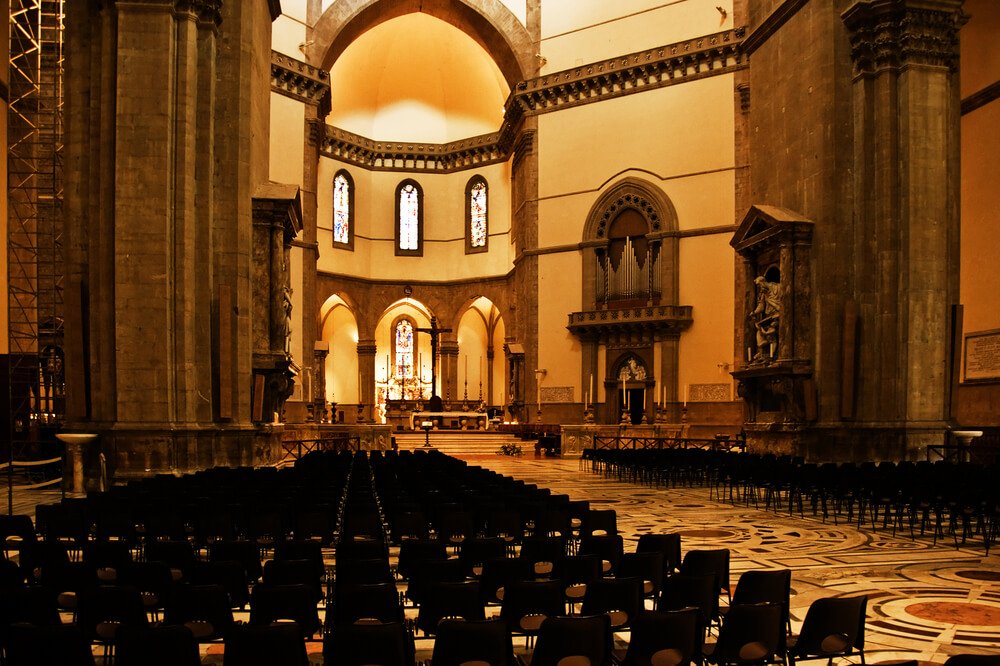
If you want to learn more about the cathedral, you can join this Florence Cathedral: Priority Entrance Tour with an expert guide that will tell you all about the history of the Duomo.
This ticket even allows you to enter through a separate entrance to skip the lines! You can do the tour in English, Spanish, or Italian.
Note that this tour does not include access to the Brunelleschi Dome.
To be honest, while this tour is one of the cheaper options, it would be my last choice because the interior of the cathedral isn’t nearly as interesting as the ability to see the dome.
However, if that’s all you can do because you’re booking at the last minute, it’s better than nothing.
2. Skip the Line Entry to Brunelleschi’s Dome and Cathedral Complex
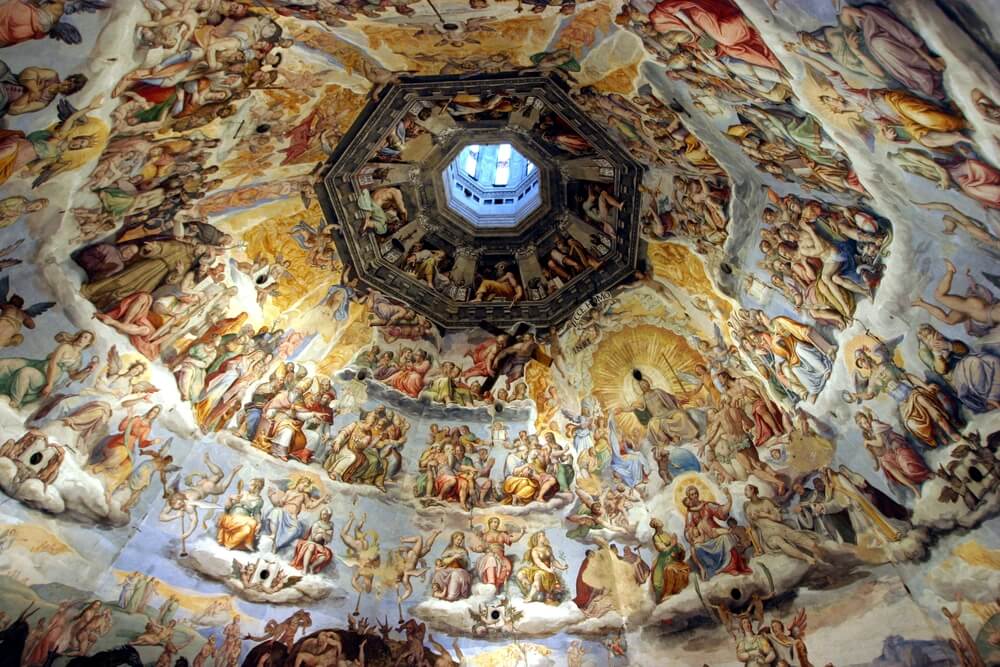
If you’re looking for a more complete experience, book this skip-the-line Cathedral + Brunelleschi’s dome entry ticket with time slot for the dome.
This is one of the more comprehensive options at a still affordable price! Keep in mind though that this ticket sells out quickly: it’s sold out entirely for a few days, and all but the best slots are taken for the upcoming few weeks.
Book about a month in advance if you want to have your choice of time slots for the Dome (there is the option of free cancellation if needed).
While the main draw of this ticket is the reserved entry for Brunelleschi’s Dome, you also get a 72-hour Duomo Complex pass that allows you to check out all the sites listed above.
That includes not only the church itself and the dome, but also the Bell Tower, the Duomo Museum, and Santa Reparata Crypt.
3. Skip the Line Brunelleschi Dome and Cathedral Complex Entrance and 2-Hour Guided Tour
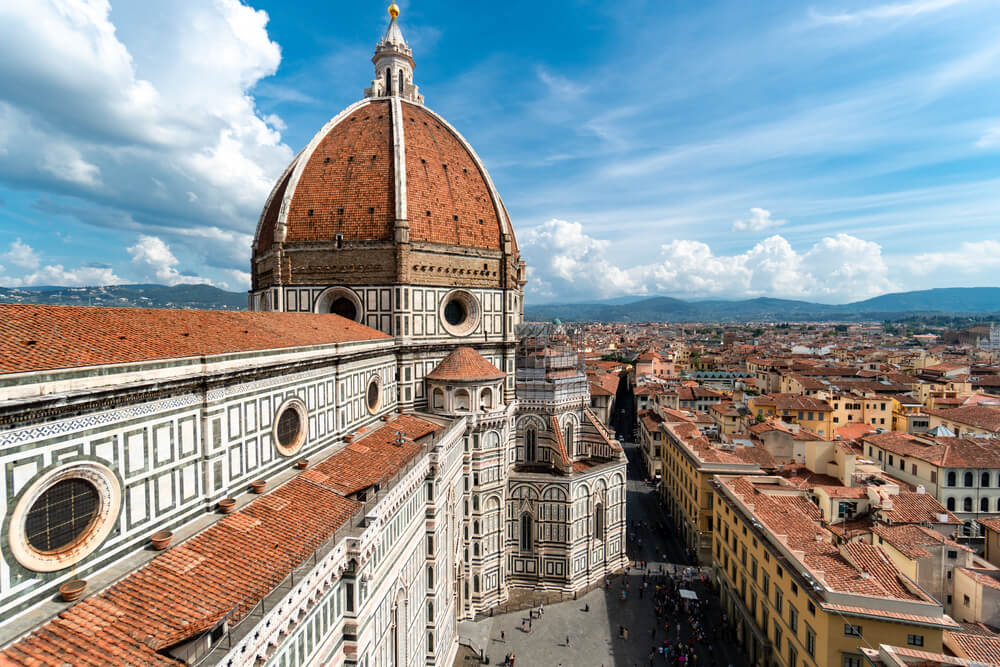
This Brunelleschi + Cathedral Complex small group tour is similar to the above, only it includes a 2-hour guided tour as opposed to only skip-the-line tickets.
Then, you can continue your experience visiting the Florence Duomo in a self-guided fashion with the 72 hour pass.
This is the creme-de-la-creme tour if you want to experience it all with a tour guide who can give you the historical context of what you’re seeing — all in a small group capped at 12 people.
Plus, you’ll still have the opportunity to tour certain parts of the complex independently, as you’ll get the 72-hour pass which allows you to see the sights this tour doesn’t cover, namely the bell tower and Cathedral crypt.
If you ask me, it’s the best of all worlds: a not-too-long tour, enough historical context to truly appreciate what you’re seeing, and then the opportunity to solo explore later!
Things to Know Before Visiting the Florence Duom
Now that you know how you can visit the various monuments of the Florence Duomo Complex, let’s chat about a few things you should keep in mind to make sure your trip is a great experience.
Buy tickets in advance.
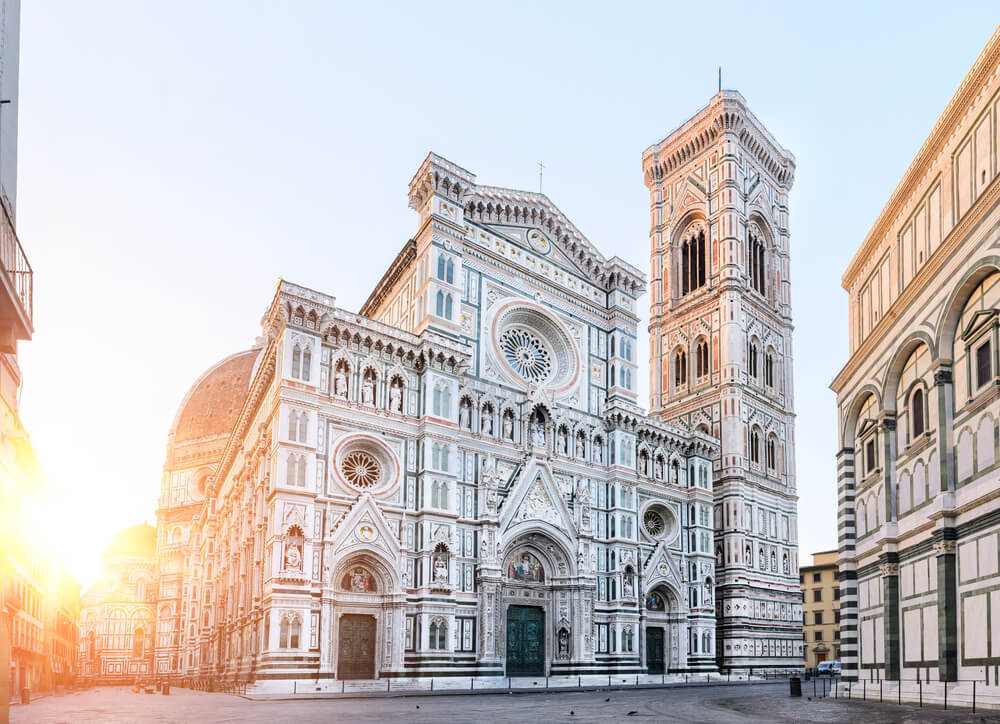
In peak season, tickets are likely to sell out quite fast, especially those including the climb to the dome, which only is accessible via a pre-reserved time slot.
If you are not planning on getting a guided tour, book your tickets online a few weeks before to have the best shot at finding your perfect time slot.
You don’t need to book specific time slots for the other monuments, so if you don’t want to climb the dome, you’ll likely have no trouble finding tickets.
Finally, although you can buy tickets at the on-site ticket office, booking online removes the stress of waiting in line, so you can use that precious time to visit other beautiful areas of Florence.
To recap our ticket recommendations:
- Cathedral Only Guided Tour (No Dome Climb)
- Skip-the-Line Cathedral + Dome + 72 Hour Pass (No Tour Guide)
- 2-Hour Guided Tour with Cathedral, Dome + 72 Hour Complex Pass
Don’t rush!
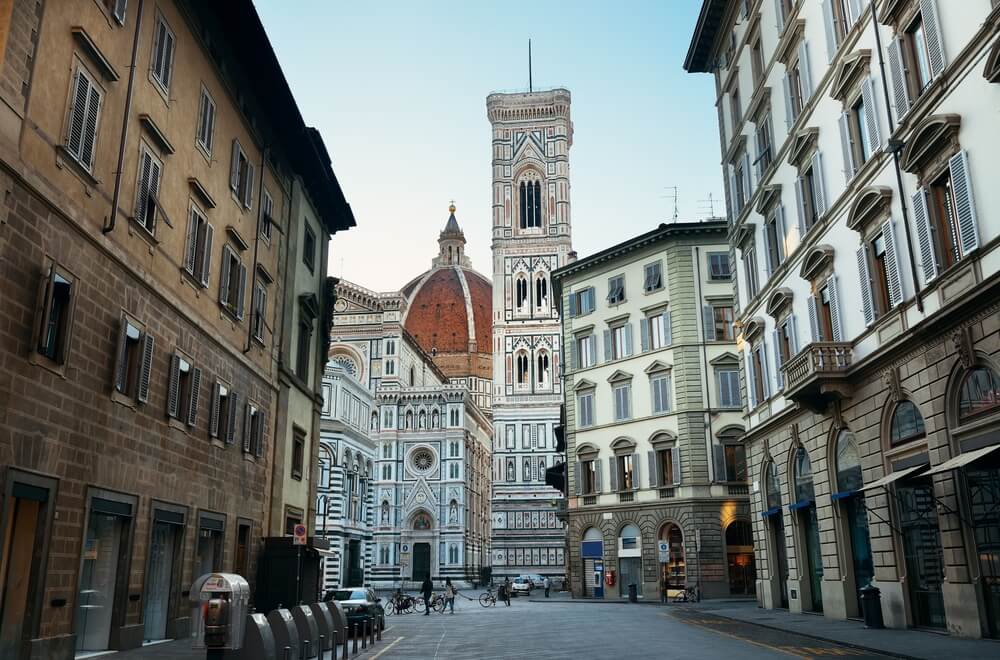
There’s a lot to see around Piazza del Duomo, and it can be exhausting if you try to fit everything in one day.
The passes are valid for three days (on all but the first ticket option listed above), so you can divide the monuments and only do one or two per day.
This way, you’ll enjoy the visits a lot more and won’t end up drained.
For instance, if you want to climb both Giotto’s Bell Tower and the Brunelleschi Dome, try to do them on two separate days (your legs will thank you).
As an extra bonus, you can even schedule your visits for different times, one during the day and the other around sunset.
Check the weather and plan accordingly!
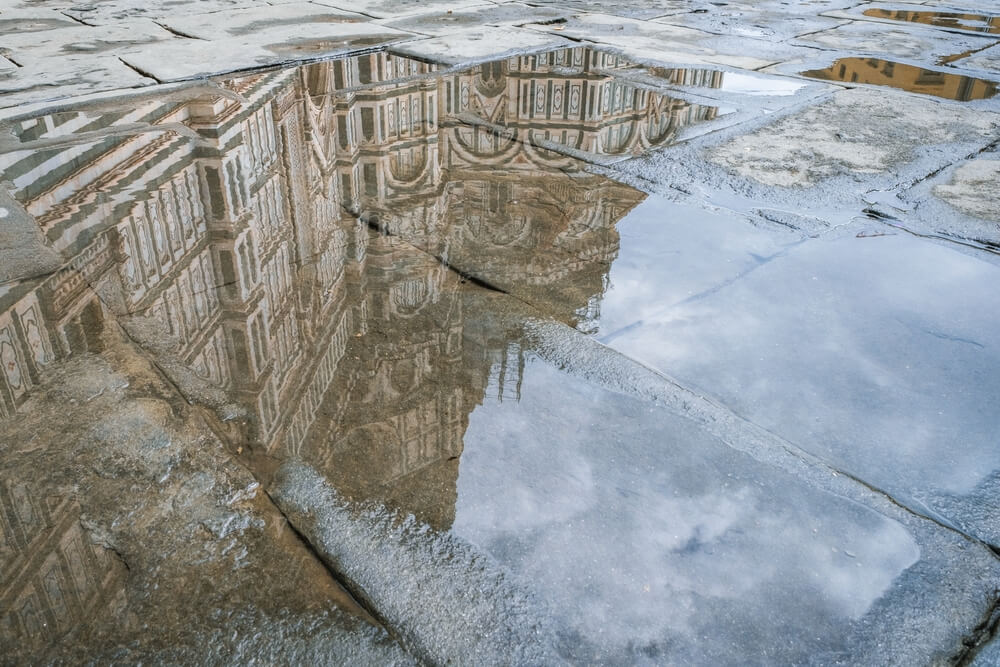
Most monuments are indoors, so you can visit them at any time without having to worry about the weather.
However, Giotto’s Bell Tower and the Brunelleschi Dome are open at the top, so you’ll want to avoid climbing on a rainy or cloudy day so you can actually enjoy the view once you get to the top!
At the same time, depending on what else you’d like to do in the city, if you see bad weather in the forecast (especially if visiting Florence in winter), you can choose to visit the museum, baptistery, and Santa Reparata during that time.
That way, you can enjoy exploring the city when the weather is better.
Dress appropriately.
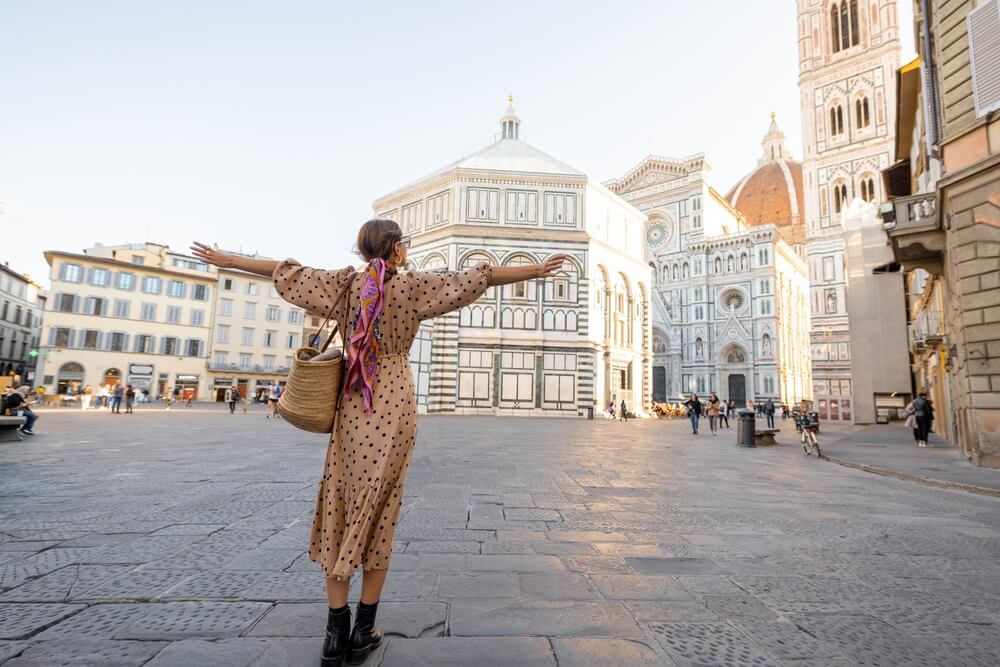
As for any other church in Italy, you should dress appropriately to visit the Duomo and St. John’s Baptistery as a sign of respect for the local culture and holiness of the site.
This means no shorts or skirts above the knees and no bare shoulders (a shawl will be fine to cover them up).
In summer, you can wear a t-shirt, or bring a scarf to cover the shoulders and wear long pants, skirts, or dresses.
Wear the right shoes.

While the dress code is a religious thing, wearing the right shoes is all about practicality.
You’ll end up walking a lot, so wear comfortable shoes.
That doesn’t mean they have to be sneakers though! You could wear walking sandals, a well-broken-in pair of boots, etc.
Especially when climbing Giotto’s Tower or the steps up to the Dome, having comfy shoes is crucial!
Don’t bring your luggage.

If you’re visiting the Florence Duomo before your hotel check-in or after check-out, store your luggage somewhere before.
The last thing you want is to drag around your suitcase while visiting the cathedral or baptistery!
Especially if you plan to climb Giotto’s Bell Tower, you can’t enter with big luggage since the stairway is very narrow.
The Duomo Museum has a cloakroom where you can leave your luggage if needed.
The other monuments don’t have such a service, so don’t forget to plan accordingly.
Pick the right time.
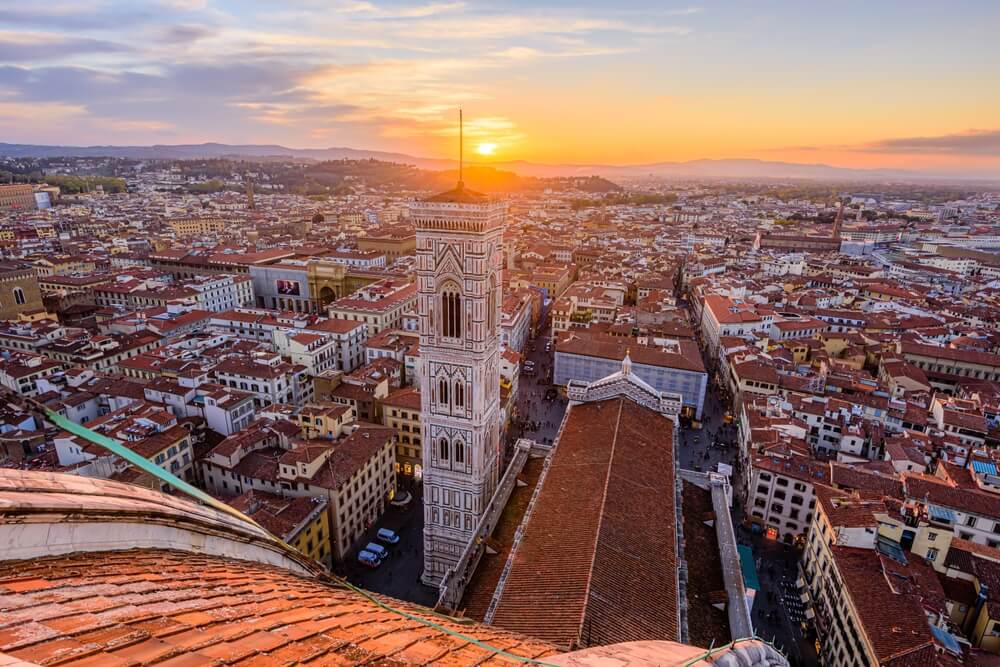
If possible, try to plan your visit to the Florence Duomo during the week rather than the weekend.
Although in the busiest season you’ll still find many people around, visiting during the week usually means you have a better chance of avoiding the worst of the crowds.
As for the time, try to visit at the earliest time possible, or right before closing time.
If you want to climb the dome around sunset, keep in mind that these time slots sell the fastest, so you’ll have to book ahead.
Finally, don’t forget to check the hours before you visit!
The museum, for example, is closed every first Tuesday of the month, unless it’s a holiday, in which case it may remain open.
Each monument also has different hours, so check the official website for the dates you are interested in.
Now that you have all the practical information you need, it’s time to start planning your visit to the Florence Duomo, this wonderful Renaissance monument!

Roxana is a Romanian-born freelance travel writer who has lived in Italy for over 15 years. She has a Master’s in Journalism and a Bachelor’s in Film Studies, and she studied at Università degli Studi di Roma Tre. Besides her native Romania, Roxana has lived in Rome, Lisbon, and Berlin, and she has traveled through much of Europe in search of hidden gems, history, and culture.